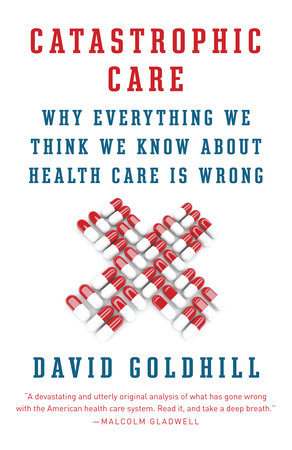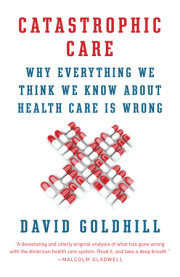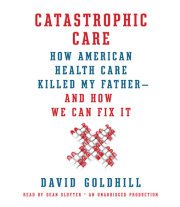Introduction
How American Health Care Killed My Father
Becky is a twenty--six--year--old who’s worked in my company’s marketing department for three years. It’s her first job out of school, and she’s done very well. She’s smart, ambitious, and poised, and her future is promising.
Becky describes herself as a “bit hypochondriacal,” so she sees two primary care physicians a year. But she’s generally healthy and has no major health care needs. With the insurance plan she’s chosen, she can see any doctor she wants, but the annual deductible doubles, from $250 to $500, when she goes out of network. Most of the treatments she uses count as preventive care, which now has no cost sharing. So with her share of the company’s insurance premiums and her out--of--pocket expenses, health care will cost Becky just about $2,500 a year. That may be a bit more than she would like, but all things considered, it’s not terrible for someone just starting out, right?
Wrong.
Becky will actually contribute over $10,000 to America’s health care system this year—-most of it through payments she’s not aware of. That’s right: health care will consume just under a quarter of Becky’s true compensation, not the 7 percent she believes. I’ll be providing a detailed breakdown of these additional—-I call them deliberately disguised—-costs in chapter 2. For now, what you urgently need to understand is that beginning on the first day of her working career, the cost of health care will be the major constraint on Becky’s standard of living matching—-much less, surpassing—that of her parents.
And it will only get worse for Becky as she settles down and starts a family. Because, as I’ll show you, even if we somehow eliminate the explosive growth in health care costs—-literally reduce growth to zero—-our current system already ensures that Becky will pay well more than $1.2 million into it over her lifetime. If Becky’s hoping the new Affordable Care Act will somehow reduce her cost, then she’s unaware that the administration’s own projections show per capita health costs rising by 5 percent per year over the next ten years (which would mean her lifetime contribution to the system will be $1.8 million, even assuming that after those ten years health costs don’t grow at all). All this assumes she never has a major illness, in which case she will almost certainly pay much more.
None of this is on Becky’s radar screen today. Although she’s probably spending more this year on health care than on anything else (except maybe big--city apartment rent), and while she describes herself as a “true bargain shopper,” Becky has no awareness at all of what health care is really costing her. She thinks about her health care benefits, not about her health care costs.
Becky hopes to be successful, perhaps someday earning “several hundred thousand” a year. That would put her in the top 1 percent of earners in America. When I ask her how much she would need over her lifetime to pay for health care, she mentions the possibility of dealing with cancer or other major issues and says “millions.” There is “no way” she could afford to pay for her care on her own. But then I ask her how a society can afford health care for anyone if even people in the top 1 percent don’t have the resources to cover their care. Where would the money come from? She’s a bit embarrassed: “I’m sorry, that doesn’t make any sense. I haven’t really given this any thought.” I assure her there’s no reason to be embarrassed: almost no one seems to have given this much thought.
I started thinking about health care because of a personal tragedy: almost five years ago, my father died from a hospital--borne infection he acquired in the intensive care unit of a well--regarded New York hospital. Dad had just turned eighty--three and had a variety of the ailments common to men of his age. But he was still working the day he walked into the hospital with pneumonia. Within thirty--six hours, he had developed sepsis. Over the next five weeks in the ICU, a wave of secondary infections, all contracted in the hospital, overwhelmed his defenses and caused him great suffering. But although his death was a deeply personal and unique tragedy for me and my family, my dad was merely one of a hundred thousand Americans who died that year as a result of infections picked up in hospitals.
One hundred thousand preventable deaths! That’s more than double the annual number of people killed in car crashes, five times the number murdered, twenty 9/11s. Each and every year!
A few weeks after my father’s death,
The New Yorker ran an article by Atul Gawande profiling the efforts of Dr. Peter Pronovost to reduce the incidence of fatal hospital--borne infections. Pronovost’s solution? A simple checklist of ICU protocols for physicians and nurses governing hand washing and other basic sterilization procedures. Hospitals implementing Pronovost’s checklist achieved almost instantaneous success, reducing deaths from hospital infections by more than half. But many physicians rejected the checklist as an unnecessary and belittling intrusion, and many hospital administrators were reluctant to push this simple improvement on them. Gawande’s article chronicled Pronovost’s travels around the country as he struggled to persuade hospitals to embrace his reforms.
It was a heroic story, but it was also deeply unsettling. Why did Pronovost need to beg hospitals to adopt an essentially cost--free idea that saved so many lives? In an industry that loudly protests the high cost of liability insurance and the injustice of our tort system, why did a simple and effective technique require such extensive lobbying?
And what about us—-the patients? Our nation is quick on the draw to close down an imperfectly assembled theme park ride or a business serving an
E. coli–-infused hamburger. Why do we tolerate the carnage inflicted by our hospitals? The hundred thousand deaths from infections are compounded by a litany of routine mistakes that create preventable blood clots, drug dosage and prescription errors, and any number of other oversights. All this adds up to an estimated two hundred thousand Americans killed each year by medical mistakes. A single fatal accident at a school or even a nightclub will make headlines in your hometown newspaper. How did Americans learn to accept hundreds of thousands of deaths from avoidable medical mistakes as an inevitability of the system?
Keeping Dad company in the hospital for five weeks was an eye--opening experience. While the facility’s diagnostic equipment was state of the art, the technology used to record that diagnostic information and track the patient was less sophisticated than the desktop computer at my local
Jiffy Lube. And although we heard much about the hospital’s efforts to maintain sterility, the patients’ trash was picked up only once a day, and often only after overflowing onto the floor. Doctors and nurses discuss the importance of a patient’s mind--set to the recovery process, and yet we saw little to no effort to make the hospital room cheerful or even moderately comfortable. And whose needs are served by the bizarre and unpredictable scheduling of hospital shifts, assigning an endless string of new personnel to care for a patient? Why had this supposedly high--quality hospital missed out on the revolution in quality control and customer service that has swept over every other industry in the past two generations?
I’m a businessman and I’ve never worked in the health care industry. But like the rest of us, I’m also often a patient, and so I can’t help noticing that the industry of health care simply doesn’t measure up to the standards of other industries in our economy.
Many of us believe that health care is fundamentally different and that applying experiences and standards from the rest of the economy makes no sense in matters of life and death. But health care is an industry. And the persistence of bad practices seems beyond all normal industrial logic. There must be a business reason that this industry, year in and year out, is able to get away with poor customer service, unaffordable prices, and uneven results—-and even a business reason that my father and so many others are unnecessarily killed.
Like every grieving family member, I looked for that reason. I wanted some person or some institution to blame for my father’s death. But my dad’s doctors weren’t incompetent—--on the contrary, his hospital physicians were smart, thoughtful, and hardworking. Nor is he dead because of indifference on the part of the nursing staff—-without exception, his nurses were dedicated and compassionate. There were no financial reasons limiting my father’s quality of care; he was a Medicare patient, and the issue of expense never came up. No greedy pharmaceutical companies, evil health insurers, mindless hospital bureaucrats, or other popular villains populated his particular tragedy. So how is it possible that my father’s death was an avoidable accident with no one to blame?
Since Dad’s death, I’ve been looking at our health care system for an answer to this very troubling question. I’ve read as much as I could get my hands on, talked to doctors and patients, asked a lot of questions, and listened much more carefully to my friends’ stories of medical care dysfunction. All of this exploration has transformed my thinking about what we can and should expect from our nation’s health care system.
I’m a Democrat and once held views about health care common in my party. But the more I’ve looked at our system, the more I’ve come to believe that the obsessions of our political debate—-universal access, health insurance regulation, cost control—-are irrelevant to the real problems that have created our mess. Despite the partisan screaming, I suspect all Americans have the same goal: high--quality, safe health care that is affordable for all. And yet the frustrating reality is that despite more than sixty years of government efforts—-representing the work of both political parties—-we are moving further and further away from what we want. Prices are higher, more people are excluded from needed care, more excess treatments are performed, and more people die from preventable errors. Why?
--
Life on the IslandOver time, I’ve come to believe that health care is indeed different from other industries, but primarily because we insist on treating it as different. Everything about health care—-how we pay for it, how we regulate it, how we judge its effectiveness, how we’re willing to accept low standards from it, even how we talk about it—-exists on a separate island from the mainland of every other service or product in our economy. Forget the rhetoric: our health care system isn’t an example of “socialism” or “profit--driven medicine.” In fact, it is such a strange beast that I’m not even sure we have an appropriate label for it. The best analogy might be the Galápagos Islands, set so far offshore from the mainland of industrial evolution and economic laws that it has produced odd, anomalous creatures of policy and regulation. Though these products of convoluted laws and rules manage to thrive on the Island of Health Care, they would not survive on the Mainland, where all other industries are forced to compete for their customers.
Every business would like to get away with high prices, poor quality, and miserable service, but this behavior carries an unacceptable cost: lost customers, lost revenue, lost profits. In health care, bad behavior doesn’t produce these bad results; bad behavior is often rewarded with additional revenue, and efficiency is penalized with less. All of the actors in health care want to serve patients well, but understandably most respond rationally to the backward economic incentives baked into the system.
At the heart of these perverse incentives is insurance. Unlike with anything else in the economy, we rely on insurance as the sole means of paying for everything in health care—-from the most routine to the most urgent. Even our government health programs take the form of insurance. But not only is insurance the costliest way of financing our spending, it is the most distortive; the insurance model requires that we turn over our role as consumers to what I call the Surrogates: private insurers, Medicare, and Medicaid. As I’ll show, their actions—-and our own absence as a disciplinary force in the health care marketplace—-create many of the incentives for bad behavior.
--
We are all patientsI first raised these ideas in “How American Health Care Killed My Father,” the cover story of the September 2009 issue of
The Atlantic. At the time, Congress was just beginning its debate on health care reform. In the months that followed, I received countless invitations to do interviews, speak at public events, engage in debates. At industry gatherings, at business groups, even at Harvard Medical School, I found myself publicly jousting with traditional experts—-economists and public policy analysts who had spent their careers studying all angles of our complex health policy mess. Although my arguments received a broadly favorable reception, the most accurate description of the article came when it was called “widely praised and completely ignored.” Everyone could find something to like. Traditional liberals appre-ciated my call for true national insurance. Traditional conservatives agreed that sensible economic incentives needed to be the centerpiece of any reform and that Medicare and Medic-aid were unsustainable. But the whole of my argument—-that we needed to rethink our entire approach, that this emperor had no clothes—-had no supporting army in the gathering political war over health care reform.
Among the hundreds of e--mails, letters, and phone calls I received was one from a woman who had also lost her father to a hospital infection: “The hardest thing for me was the indignities this proud and humble man suffered, and the helplessness we felt through it all. When I talk to other families who have had a similar experience, they can still recount each hour in stark detail.” Each of the many notes like hers confirmed what my father’s death had already seared in me—-fixing our health care system is about much more than money and politics. A call for true health care overhaul may have no natural constituency among the interests fighting over health care policy, but it should have an ally in the largest and ultimately the most important interest group: patients. And that includes every single one of us.
Health care is not an abstract policy issue for me, and I suspect it isn’t for most families. I worry to the verge of panic when my mother or another relative needs to enter a hospital, even for a routine test. I watch more and more of my employees’ compensation eaten up by health expenses and see my middle--aged friends making their professional decisions on the basis of health coverage. I listen to doctors complain that they are becoming glorified insurance clerks.
While the debate has focused on the vulnerability of the uninsured and uncovered, this book will show that our current health care system is also a disaster for the
insured. It places ever growing burdens on young people and the middle class and impedes our ability to advance our standard of living and to create jobs. Our massive and failing Medicare and Medicaid programs are already unsustainable and unfixable. If you or your loved ones rely on either program for health or financial security, then you’re already at risk.
--
The Affordable Care Act (aka Obamacare)For all its promise of major reform, the final structure of the Patient Protection and Affordable Care Act of 2010 legislation (which, for simplicity’s sake, I’ll refer to as the ACA) turned out to be remarkably similar to all the other previously enacted bills: its central thrust is for ever more insurance to pay for health care. As before, additional government aid and rules to expand coverage are accompanied by a raft of complex restrictions, regulations, and pilot programs intended to mitigate the incremental cost. Despite the good intentions of its authors, the ACA is less a reform of our health care system than an extension of its current principles to their logical end.
With the costs of health insurance already a massive, if hidden, burden on American families, the ACA loads more cost onto private insurance. Medicare faces $36 trillion of unfunded liabilities, and yet the ACA has no specific plan for managing this impossible burden. And though spending for Medicaid already consumes a bankrupting 22 percent of state government budgets (just over 14 percent after federal contributions are excluded), the ACA promises a massive expansion of the program. In a system burdened by complexity, bureaucratic explosion, and lack of innovation, the ACA paves the way for even more rules, many of which are merely mandates for future rules and ever more committees and commissions. The problem with the ACA isn’t that it represents “government takeover of health care” or “socialism” or even the famous but nonexistent “death panels.” The problem with the ACA is that it’s so old--fashioned.
Should you ever have the time to read the roughly nine--hundred--page bill, you’ll be struck by how sensible it is. The ACA is health reform by technocrats, by those experts who believe that any problem can be fixed by an intelligent rule, a commission, or a subsidy. They have made a truly valiant effort, mandating prospective solutions to an extraordinary range of health care dysfunctions. But though I admire their intentions and ambitions, I contend that they have missed the big picture: the underlying insurance--based structure of our health care system drives excess treatment, cost inflation, and medical errors. It is this structure that needs to be changed. As I will discuss, I suspect that the unintended consequences of the ACA will only further exacerbate these perverse incentives, raising the overall cost of care, reducing access to essential treatment, and undermining the efforts of dedicated professionals to practice effective medicine.
--
Changing the conversationIf we, the patients, are on the receiving end of such poor care, why do we continue to support only slight variations of the status quo? Fear. Afraid of losing access to health insurance, we continue to support expansion of insurance coverage. Worried about denial of reimbursement for needed procedures, we continue to endorse additional mandates. Concerned about our parents, we continue to oppose any limits on Medicare. Angry about high prices, we continue to favor limits on payments to providers and drug companies and on their spending for “unnecessary” expenses. Terrified of medical errors, we continue to demand ever greater rules constricting the profession. The basic policy approaches still rest on our broad popular approval: this is what we, the people, want.
And yet each and every one of us has at least one health care horror story: interminable waits, incomprehensible billing, inexplicable mistakes, disorganization, lost test results, nonexistent follow--up, even utter incompetence. Many of us are angry about our experiences with health care, but we see the problems as inescapable side effects of an advanced and complex system. Health care is too complicated to get the little things (like us patients) right.
I disagree. We’re surrounded by complex things made simple. I don’t really understand how this laptop I’m writing on works. Or how a GPS knows where I am when I drive. Or how an ATM handles cash deposits. Or how I can instantly change TV channels beamed to me from a satellite. In each of these examples, some company profited by taking something complex and making it simple for me to use. In health care, no one—-including our politicians—-profits by making it easier for us.
This book is written from the perspective of patients, or—-as we’re called off the Island—-consumers. I think we can learn a lot about our health care problems by contrasting what we see in health care with what we see at Wal--Mart or Starbucks, by comparing health insurance with homeowners’ insurance, by keeping in mind our experience with the corner auto mechanic while evaluating a hospital.
Some readers may feel these comparisons trivialize health care, which, after all, deals with matters of life and death, not toothpaste, coffee, or oil changes. But I remind these readers that our current approach frequently fails at these very matters of life and death. As I write this, Medicare has just announced the most recent results of its effort to reduce hospital errors through regulation and financial penalties. The frequency of major errors increased during these years; roughly a quarter of Medicare hospital patients are now -victims of a major error. So I ask you to keep an open mind. How can health care benefit from lessons learned in other services?
--
A better approach Over the past forty--five years, our health care system has transformed an essential service into what I call the Beast—-a creature that has destroyed jobs, reduced incomes, threatened financial security, and diverted massive resources away from other worthwhile endeavors. The Beast also tolerates—-even encourages—-excess and careless medicine, causing great physical harm. And despite all the spending, many Americans still have inadequate access to needed care or receive substandard care. On the Island, it is considered normal to quote health care waste estimates of $600 billion a year, or 25 percent of spending. Think of the good that could come from spending that wasted $600 billion on almost anything other than health care.
I believe that my father’s death and the health care expense mountain that Becky must climb have the same fundamental underlying cause: the use of the insurance model to fund all health care expenses. This view is at odds with much conventional thinking in health care—-that we must expand insurance to deal with high care costs, that only insurers have enough market power to discipline rising prices, that insurers’ vested interest in our health can drive greater safety and quality. In the following chapters, I will show not only why this conventional wisdom is wrong but how, like with Becky’s hidden health care charges, it prevents us from seeing what is really going on in health care.
Blaming incentives is far less dramatic than discovering a villain, but thinking in systemic terms is the only way to understand—-and fix—-an industry as multifaceted and complex as our nation’s health care. And I believe this is exactly what we need: a full--scale intervention. We must dismantle the perverse incentives embedded in every layer of our system and force health care off its Island and back to the Mainland. Until we do, clever fixes and passionate political debates will offer only superficial solutions, the equivalent of rearranging deck chairs on our own health care
Titanic.This book will approach the issue from a very different perspective from those of the experts who guide much of our health care policy. On the Island, health care (as opposed to health, something quite different) is a good above all others, and providing as much of it as possible is the ultimate objective of public policy. On the Island, the problems of health care are complex because, well, health care itself is and must be complex. And most strangely, on the Island, our society needs ever more money to spend on health care because we are somehow getting sicker (despite all evidence to the contrary) or older (despite this in itself being a measure of improved health) or more dependent on technology (despite technology’s cost savings in all other sectors).
I believe this is nonsense. We’ve spent five decades undermining all proper economic functioning in health care and are now at a loss for what to do about our dysfunctional health care system. We need to require of health care what we do of any consumer industry, but to achieve these goals, we have to stop believing that health care is so special that the normal economic rules don’t apply.
I believe that true solutions to the problem are at hand. Liberals have long argued for comprehensive national health insurance, with conservatives pushing for more market--oriented approaches to health care. I believe we need
both if we are ever going to address today’s extreme dysfunction. Society does demand a health care safety net—-and it’s certainly reasonable, considering that massive health care costs can be imposed on any unlucky individual from birth. But as I’ll show, insuring everyone isn’t the same as insuring everything. We should have a national cradle--to--grave safety net, but one that covers only truly insurable events: health crises that are major, rare, and unpredictable.
At the same time, we need to recognize that the health care system won’t function properly—-indeed, will continue to be downright dangerous—-unless it is accountable to actual consumers. And the only way to increase consumers’ role is to shift many of the enormous resources now passing through insurance and government programs back to us. We will need to confine insurance to what it does efficiently (protect us against catastrophe) and remove it from what it does disastrously (serve as the payment system for all care). Only then will we align health care incentives with our interests.
The government, too, should be radically recast in a new role—-not necessarily bigger or smaller, but truly different. I believe a sustainable health care system requires a simplified but expanded role for government in protecting all Americans from health catastrophe. So this book calls for a national health insurance program that covers all Americans from cradle to grave, but one that is limited to true health catastrophes. Then we need to get the government out of the business of directly purchasing care so it can be an unconflicted advocate for patient--consumers: promoting transparency and competition, driving the collection and dissemination of data, and punishing (rather than funding) those who practice unsafe care.
Over the past forty--five years, Americans have been made utterly dependent on the current system, so it may require a generation to complete health care’s transition to a more sensible and sustainable economic structure. But as I’ll demonstrate in the following chapters, we can today make fundamental changes that will have large and immediate impacts in changing the performance of our system. With all the focus on politics and public policy, some of the necessary changes are in fact already occurring at the fringes of our system—-as the burden of our current system forces consumers, employers, and providers to explore new treatment and business models. Achieving a truly reformed health care system will be hard—-maybe even politically impossible today—-but at some point soon it will be inevitable. Inevitable because of the system’s unsustainable cost to Becky. And inevitable because of what happened to my father and threatens so many of us.
Copyright © 2013 by David Goldhill. All rights reserved. No part of this excerpt may be reproduced or reprinted without permission in writing from the publisher.







